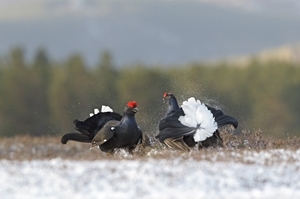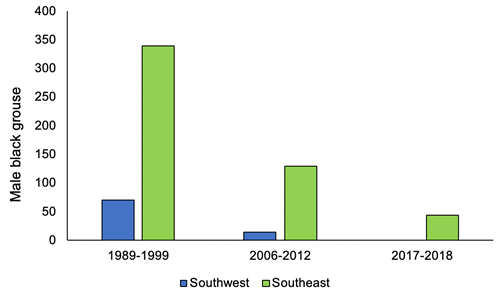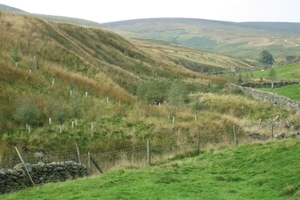Key points
- Black grouse numbers have declined in Scotland and are considered to be a species of high conservation concern.
- Their display sites, known as leks, are found in open habitats such as moorland, farmland, and forest clearings.
- This study monitored trends in the number of male black grouse at leks in Scotland between 1989 and 2018, and explored changes in relation to habitat types and moorland management.
- The number of males at the leks surveyed fell from 70 to 0 in the southwest and 320 to 44 in the southeast.
- Leks that were still occupied in 2018 had more rough grassland and less conifer woodland cover nearby than extinct leks, but declines were similar across management types.
- Leks on moorland that was managed for driven red grouse shooting had twice as many males.
- Conservation of black grouse requires a combination of retaining/restoring rough grassland and moorland, and establishing areas of new native woodland in combination with predator control.
Background
 Black grouse in the UK have declined in numbers and range over the past 100 years. Black grouse are now considered to be a species of high conservation concern, which means action is needed to stop their decline.
Black grouse in the UK have declined in numbers and range over the past 100 years. Black grouse are now considered to be a species of high conservation concern, which means action is needed to stop their decline.
Two thirds of remaining black grouse in the UK are found in Scotland, where they are usually found in mosaics of moorland, moorland-fringe, young forest and broadleaf woodland. Commercial forestry expansion has been linked to their decline. This is because commercial forests initially provide excellent habitats when they are young, but because they are densely planted, the canopy quickly closes, and the plants on the forest floor that are favoured by black grouse are shaded out.
To monitor black grouse populations, scientists count the number of males that are seen at sites known as ‘leks’. These sites are where male grouse perform mating displays and are generally found in moorland, farmland and forest clearings.
In this study, the authors investigated changes in the numbers of black grouse between 1999 and 2018 and related these changes to habitat and moorland management types. Wider surveys of leks across southern Scotland between 2006-12 were used to measure habitat within lek ranges and compare this with habitat in the wider landscape. The authors also compared size of occupied and unoccupied moorland patches.
What they did
The authors surveyed black grouse in two areas of southern Scotland that were predominantly moorland and forestry.
Black grouse were first surveyed between 1989-1999. These areas were then re-surveyed between 2006-2012 and again between 2017-2018. Surveys were carried out at lek sites during the breeding season in April and May of each year.
To describe habitat around leks, the authors classified habitat within 1km of the lek, as habitat within this distance is used for feeding as well as breeding. Habitat was classified into one of six types: dwarf shrub heath and bog, acid and rough grassland, farmland, broad-leaved woodland, conifer woodland, and other. The level of predator control at each lek site was also considered. This is because black grouse can be associated with the edges of heather moorland that is being managed for red grouse shooting. In these areas, gamekeepers are often employed to control predators, for example foxes and carrion crows, that are also common predators of black grouse.
The authors also looked at the size of the moorland habitat patch to assess the size of occupied moorland areas.
What they found
The author surveyed 121 lek sites across two areas of Scotland between 1989 and 2018. Black grouse numbers declined by 100% in the southwest from 70 males to zero and by 87% in the southeast from 340 males to 44 (Figure 1).
The authors found habitat differences between occupied and extinct leks. Occupied leks had more acid and rough grassland and less conifer woodland than extinct leks. Declines were similar across moorland management categories.

Figure 1: The average number of male black grouse in each area of Scotland during the three survey periods.
Wider surveys during the 2016-2012 survey found that at acid and rough grassland, and dwarf shrub heath and bog were the two preferred habitats within 1km of 197 leks. There were also twice as many males at leks on moorland managed for driven red grouse shooting than on moorland managed in other ways (e.g. for walked-up red grouse shooting or unmanaged).
Of 23 moorland patches in the study areas, almost a third were occupied by leks. Occupancy of these patches was related to patch size, with occupied patches of moorland generally being 26 times larger than unoccupied patches.
What does this mean?
 This study showed that moorland is an important habitat within lek ranges for black grouse. Moorland is key for breeding, displaying, and providing the main food source for black grouse throughout the year. Moorland patches need to be connected to other suitable areas to allow black grouse to move between them.
This study showed that moorland is an important habitat within lek ranges for black grouse. Moorland is key for breeding, displaying, and providing the main food source for black grouse throughout the year. Moorland patches need to be connected to other suitable areas to allow black grouse to move between them.
In southern Scotland, black grouse have declined in all habitats, but at leks that were retained, moorland and rough grassland were the most common habitats, while extinct leks had more conifer woodland. The Scottish government aims to increase woodland cover in Scotland, with moorland fringe habitats likely to be targeted for further planting. This may further reduce the availability of moorland fringe habitats as well as providing habitats for predators of black grouse.
To help prevent the extinction of black grouse from southern Scotland, we need immediate conservation action. This means retaining and restoring rough grassland and moorland, establishing new native woodland, and predator control. Plans should aim to connect moorland patches in the landscape by limiting and removing inappropriate forestry (for example commercial non-native plantations) and managing the suitable habitat patches to support black grouse.
Read the original abstract
Warren, P., Land, C., Hesford, N. & Baines, D. (2019) Conserving Black Grouse Lyrurus tetrix in southern Scotland: evidence for the need to retain large contiguous moorland habitat within a forest-moorland landscape, Bird Study, 66:4, 494-502.